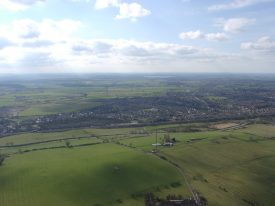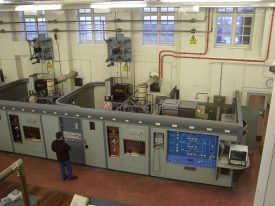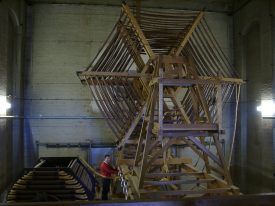The beginning
Following the First World War, the government were determined to set up the long delayed Imperial wireless network. They wanted the station in this country to be government run and the General Post Office were given the job.
Hillmorton, Rugby was first mentioned as the chosen site on 14th June 1923, and on 1st January 1926 the GBR (16 kHz) Long Wave (Very Low Frequency) service opened. The transmissions were in Morse code with a transmitter output power of 350kW – at that time the world’s most powerful transmitter using thermionic valves, giving Worldwide coverage. The aerial was suspended from 12 820ft masts built by Head Wrightson & Co. Ltd. of Thornaby-on-Tees.
Just a year after the Radio Station opened, the first radio telephone service from the UK to the USA began. Later this service could carry a maximum of two telephone calls. The cost of a call during the first year of service was £15 for three minutes, about £600 at today’s prices. The service was transmitted from Rugby, and the receiving station for the return leg of the circuit was at Wroughton in Wiltshire.
Short Waves (High Frequency)
Although circuits on Short Wave were not quite as reliable as Long Wave, the transmitters needed much less power and smaller aerials. This reduced costs and increased demand for short wave circuits. Therefore, a second building (Rugby ‘A’) was opened in 1929, and by 1935 Rugby was capable of transmitting many, mainly telephone, circuits to any country anywhere in the world.
During the Second World War, from 1943-1945 Rugby transmitters were used to jam German night fighter WT transmissions. This was called operation “Corona” and used fluent German speakers at RAF Kingsdown to send out false and misleading information.
Rugby Radio at its Peak
The size of the site was increased from 900 to 1600 acres by the purchase of land on the Northamptonshire side of the A5 Watling Street. A new building, Rugby ‘B’ as it was called, was opened in July 1955 by the Postmaster General Dr Charles Hill (The wartime “Radio Doctor”). Rugby now had 57 transmitters and was the biggest radio transmitting station in the world.
In the mid 1960s, circuits at Rugby were set up for use by NASA on the Mercury and Gemini space flights. The “Concorde” aircraft also had a radio circuit through Rugby. Because of its height and speed it couldn’t use satellite services, so when out of VHF range over the Mid-Atlantic, it used HF for its “Speedbird” communications back to British Airways HQ.
During the Falklands War in 1982 a special South Atlantic short wave circuit was urgently set up for the MoD. This, together with the GBR VLF transmitter used by the MoD(N), helped in the war effort.
The beginning of a slow decline
When the first transatlantic cable opened in 1956, some of the traffic started to move away from Rugby. Over the next ten years Rugby changed from carrying the high density telephone traffic of North America and Australasia, into providing better telephone and teleprinter services to countries in areas that had no direct cable access. These countries (in Africa, South America, Asia, Iceland etc.) only required a small number of circuits. Press services for Reuters and London Press Service (LPS) continued with teleprinter news and picture transmissions.
With the advent of satellite communications, Short Wave International land based, point-to-point, radio services continued a slow decline. Other Radio Stations closed, as the remaining services were concentrated at Rugby. Between 1987 and 1992 the station was converted to carry an improved long range maritime service. Finally even the ships services started to transfer to satellite. The number of transmitters required reduced and all maritime commercial services were concentrated at the ‘B’ Building. The ‘A’ Building closed as a radio station in the early 1990s.
The End is Nigh
The ‘B’ building maritime services finally closed at the end of April 2000. This left only two telegraphy and the Time Signal services at the original building now called Rugby ‘C’. The remaining four 820ft masts were demolished at 15:00 BST on Thursday 2nd August 2007.
The full article is available in the ‘Downloads’ section below.











Comments
Thanks for this. The radio masts were always a sign we were close to home when I was younger.
This is very interesting reading, I live in Lennon Close and the masts were always a welcome sight, especially when returning home along the A14.
Is there any information relating the land use before the radio station as I believe it was an aerodrome and some use during WW1
About 80 acres, the very north end of the Radio Station site, had from 1916-1919 been part of a First World War airfield. The Lilbourne airfield, as it was called, had hangers, workshops and a grass airstrip in Hillmorton, Warwickshire. However, as the administration block and living quarters were further up the Watling Street on the opposite side of the road (now the truckstop) in Lilbourne, Northamptonshire the whole airfield was named “Lilbourne”. It was used for training purposes and in its final year as the Midland Area Flying Instructors School, using AVRO 504 aircraft. In June 1919 the Government put the airfield up for sale. Little did they know that in about four years they would be buying it back.
Hi,
I’m really intrigued by these Arials and their cultural importance. I grew up in Rugby, my family moved there when I was young after my dad left the Navy. He was actually a Radio Engineer during the Falklands war so would have used these arial’s in his communications. Are there any still standing?
Kind Regards,
Alex, FYI there are only a few Short Wave/High Frequency masts left standing on the South end of the ‘B’ site in Northamptonshire. (None are in use).
On the Warwickshire side of the site (‘C’ & ‘A’ sites), Eight of the twelve 820ft (250m) masts were demolished on the evening of 19th June 2004. The other four were felled on 2nd August 2007. The smaller Short Wave masts were demolished in March 2015.
For the 1982 Falklands war, as well as the Long Wave GBR submarine transmitter, there was a special Short Wave (H.F.) circuit set up from Rugby ‘B’ Building.
My Father was born in 1895 at what I believe was Hollmans Farm in the shadow of the masts .The land I believe belonged to my Grandfather and after the Great War was purchased from him by some Ministry. He then bought Biggin Hall farm at Thurlaston where I was born in 1942. My Father used to take me to look at the masts and land about ; so the lights at night became a beacon. I seem to remember too him taking me to see twin engine bombers at what I think was Lawford Heath. Was there also a radio station at Daventry?
Add a comment about this page